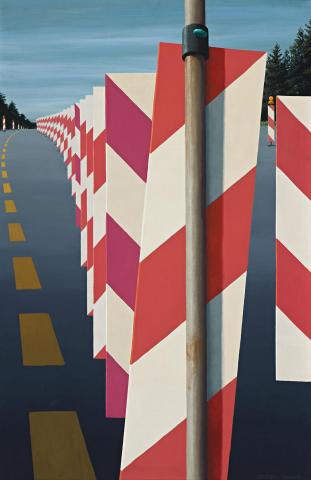AUTOBAHN IN THE BLACK FOREST II, 1979-80
JEFFREY SMART
oil and synthetic polymer paint on canvas
100.0 x 65.0 cm
signed lower right: JEFFREY SMART
Australian Galleries, Melbourne
Private collection, Melbourne
Jeffrey Smart, Recent Paintings, Redfern Gallery, London, 11 November – 4 December 1982, cat. 2
Jeffrey Smart, Recent Paintings, Australian Galleries, Melbourne, 22 March – 9 April 1983, cat. 8
Jeffrey Smart Retrospective, Art Gallery of New South Wales, Sydney, 27 August – 31 October 1999,
Art Gallery of South Australia, Adelaide, 26 November 1999 – 6 February 2000,
Queensland Art Gallery, Brisbane, 10 March – 21 May 2000,
Museum of Modern Art, Heide, 10 June – 6 August 2000, cat. 60
Quartermaine, P., Jeffrey Smart, Gryphon Books Pty Ltd, Melbourne, 1983, cat. 740 (illus., frontispiece)
McDonald, J., Jeffrey Smart: Paintings of the'70s and '80s, Craftsman House, Sydney, 1990, pp. 100–101, pl. 23 (illus.)
Capon, E., Jeffrey Smart Retrospective, Art Gallery of New South Wales, Sydney, 1999, pp. 13, 210, cat. 60 (illus., with detail, pp. 156–157)
Pearce, B., Jeffrey Smart, The Beagle Press, Sydney, 2005, pp. 248, 255 (illus., with detail, pp. 154–155)
During 1979 into 1980 Jeffrey Smart painted several brilliant pictures on his favoured theme of road signs. Beginning with The Guiding Spheres II (Homage to Cézanne) and its departing trucks, he gave full celebration to signage in a feast of diagonals in the paintings Autobahn in the Black Forest I and II. While the use of the prominent diagonal can be traced back to another major work, End of the Autostrada ,1968, its dominance reached its apotheosis in Autobahn in the Black Forest II where no trucks or figures intrude upon its splendid minimalism. A symphony in red and white stripes with subtle variations in a pinkish mauve, even the tall trees of the forest are put in their place in this hymn of praise to the man made. If the focus were any closer it would have become an entirely minimalist work of Colourfield fascination. While a master of the figurative, abstraction is never far away. Smart said 'I believe that every painting should succeed as an abstraction first, and I try to paint abstractions that look realistic.'1 Nevertheless, his images are so intensely realised that they take on the super real, the surreal, as he makes the commonplace extraordinary for our special attention. Compositionally dynamic, rhythm is developed between negative and positive space. There is balance and imbalance. The directional signs are not quite straight. On some, angles are reversed in a tug of war, setting up that contradiction between recessional movement and utter stillness. Smart delights in such visual games, continuing contradictions through the interplay between illusionism and emphasis on the flat surface of the painting. The trompe l'oeil effect of the supporting pole casts its curved shadow across the smooth bands of red and white, which themselves lead the eye up the picture. Then conversely these boards create an illusion of depth through diminution and repetition.
It is vintage Smart, redolent with his love of paradox, ambiguity and enigma. The magic of his realism excites, pleasing the eye and challenging the intellect through idiosyncratic metaphorical reference. Of his interest in freeways and their signage, Smart wrote in his autobiography, 'Italy was even more scenic from the autostrada - no hoardings were permitted; the only signs were those needed for the traffic and I found them beautiful, they were so well designed.'2 During 1968 Smart deepened his familiarity with them, travelling to Sicily in April, Munich in July and then on to Bayreuth for the festival in honour of his beloved Wagner. These journeys north would have provided him with opportunities to familiarise himself with the Black Forest in southwest of Germany. In looking at his art, however, one must remember that he said 'The subject-matter is only the hinge that opens the door, the hook on which one hangs the coat.'3 In Autobahn in the Black Forest II Smart creates a static image of frozen isolation within the crowded rush of the busy freeway as the road sweeps over the horizon and into the void of the modern world.
1. Quoted in Capon, op.cit., p. 38
2. Smart, J., Not Quite Straight: A Memoir, William Heinemann, Port Melbourne, 1996, p. 386
3. McGrath, S.,'Jeffrey Smart', Art and Australia, Vol. 7, No. 1, June, 1969, p. 34
DAVID THOMAS
